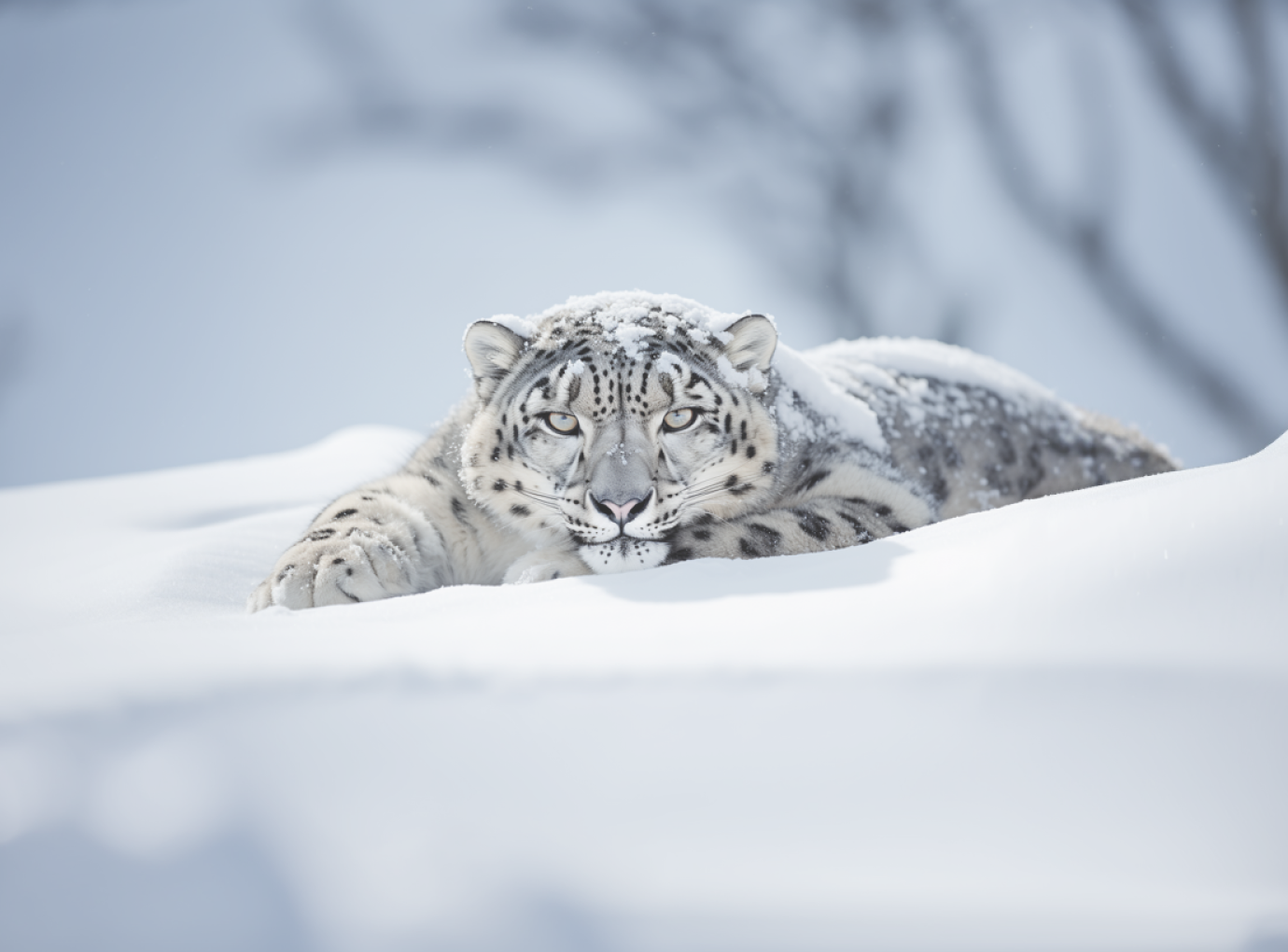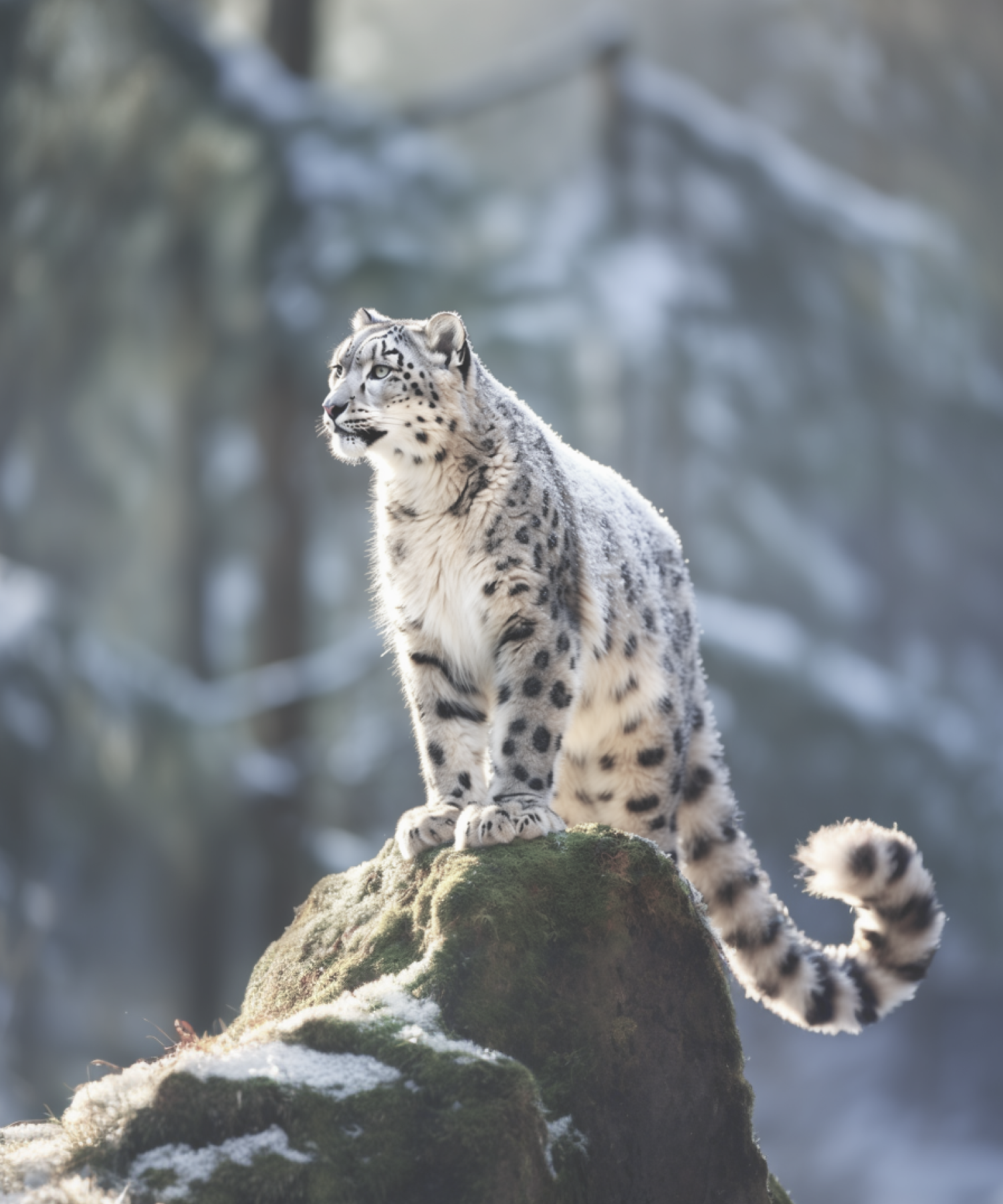Numbers of snow leopards are rapidly declining due to illegal hunting, trapping and destruction of their natural habitat. Irbis are included in the International Red Book as an endangered species. Work is underway to conserve this unique predator and its habitat



Irbis — Snow Leopard. An endangered species of wildcat

There are between 2,700 and 3,400 individuals left in the world
Irbises are large carnivores living in the mountainous regions of Central Asia
Outwardly, they resemble a big cat or small leopard, but with thick, fluffy fur that helps them keep warm in cold conditions.
Irbises have excellent camouflage that helps them hunt their prey in snowy and rocky conditions. Their coat has a silvery gray or yellowish-brown color with light black spots. This coloration allows them to blend in well with their surroundings and remain invisible to their prey.
The lifestyle of the irbis encompasses a variety of mountain ecosystems, including high mountain cliffs, coniferous and mixed forests, alpine meadows and rocky deserts. They are well adapted to cold climates, as their fluffy fur and thick tail help them keep warm during the colder months.
Irbis are solitary animals, they lead a secretive lifestyle and prefer to avoid humans.
The lifestyle of the irbis encompasses a variety of mountain ecosystems, including high mountain cliffs, coniferous and mixed forests, alpine meadows and rocky deserts. They are well adapted to cold climates, as their fluffy fur and thick tail help them keep warm during the colder months.
Irbis are solitary animals, they lead a secretive lifestyle and prefer to avoid humans. They are active mainly at night, spending most of their time hunting. Their prey includes ibex, deer, wild boar, red deer, hares and other small animals.
One of the most amazing features of irbis is their ability to traverse vertical rock walls. They can easily navigate steep mountain slopes and jump long distances, stalking their prey in rough terrain.
Irbis are solitary animals, they lead a secretive lifestyle and prefer to avoid humans. They are active mainly at night, spending most of their time hunting. Their prey includes ibex, deer, wild boar, red deer, hares and other small animals.
One of the most amazing features of irbis is their ability to traverse vertical rock walls. They can easily navigate steep mountain slopes and jump long distances, stalking their prey in rough terrain.
They are active mainly at night, spending most of their time hunting. Their prey includes ibex, deer, wild boar, red deer, hares and other small animals.
One of the most amazing features of irbis is their ability to traverse vertical rock walls. They can easily navigate steep mountain slopes and jump long distances, stalking their prey in rough terrain.
The tail of Irbis the Snow Leopard The tail of Irbis the Snow Leopard. The tail of Irbis the Snow Leopard

The tail of the snow leopard is one of the most amazing and unique parts of its body. In appearance, the tail is quite fluffy and thick. The length of the tail is about half of his body length, which is quite long compared to other cat species.
The snow leopard’s tail helps it keep its balance on steep and uneven surfaces such as cliffs and snow slopes. It also helps it maneuver and move over snow and ice. Due to the flexibility and musculature of the tail, the snow leopard can use it as a handle to balance itself and change the direction of its jumps and leaps.
Another interesting feature of the snow leopard tail is its coloration. It usually has a dark stripe at the tip or several dark circular stripes. However, each snow leopard tail has a unique coloration, which helps researchers and rangers to preserve their identity and track them in the wild.
The snow leopard’s tail is an important and adaptive part of its body. It plays a key role in balance, maneuverability and helps the snow leopard adapt to the cold and mountainous conditions of its natural habitat.
Why are snow leopards disappearing?


Poaching and illegal trade
Destruction of their natural habitat
Irbis are hunted for their beautiful fur pelt, which is in demand on the black market. Irbis are hunted illegally and without proper control, resulting in an unacceptable population decline
Expansion of land for agriculture, road construction, and mining are causing loss of suitable habitat for irbis


Conflict with people
Climate change
Irbises sometimes attack livestock or fall into traps set for other predators. Damage caused by irbises may increase the likelihood of them being killed
Reduced snow cover and worsening conditions for prey hunting lead to a decline in the irbis population

Impacts of the extinction of irbis on ecosystems and humanity
Irbises are the top of the food chain in their ecosystems, controlling populations of small animals. Their extinction could lead to overpopulation of some prey species and a decline in populations of other species
Irbises are the top of the food chain in their ecosystems, controlling populations of small animals. Their extinction could lead to overpopulation of some prey species and a decline in populations of other species
Impacts of the extinction of irbis on ecosystems and humanity
Threat to biodiversity
Irbises are keystone species in their ecosystems and play an important role in maintaining biodiversity. Their extinction could lead to the loss of some plant and animal species that depend on the regulation of their populations
The study of irbis provides unique insights into the behavior, adaptations, and ecology of these animals. The extinction of irbis could mean the loss of valuable scientific data and limit our understanding of wildlife
A threat to the people themselves
Irbises are predators and are capable of attacking livestock and domestic animals. Their extinction could lead to an increase in other predators that could threaten agriculture and livestock production

Economic impact
Irbises are a symbol of wildlife and attract tourists, contributing to the development of the tourism industry. Their disappearance could have a negative impact on the economic development of the region, which depends on tourism revenue

What is already being done to conserve the species?
Establishment of protected areas
National parks, reserves and other protected natural areas where irbis can live without persecution or destruction of their habitat are supported
Conducting monitoring and research
Irbis behavior, reproduction and population status are studied. Monitoring makes it possible to assess the effectiveness of measures taken to conserve the irbis population
Restriction of hunting and trade
Restrictions are placed on the hunting of irbis and their trade is banned to reduce pressure on the population
Conservation and restoration of irbis habitat
Measures are being taken to protect and restore the natural habitat of irbis, including surveying and protecting their nesting sites and migration corridors, and preventing the destruction and pollution of their territory
Organization of educational events
Educational activities and campaigns are conducted to raise people's awareness of the importance of irbis conservation and their unique role in the ecosystem







How to help conserve irbis? How to help conserve irbis? How to help conserve irbis?
*The links are provided for informational purposes, it is recommended to check the structure and reliability of the respective organization before making a donation
You can financially* support irbis protection projects or volunteer to help them in irbis habitat areas



Share information about irbis issues with your friends, family and community. Tell them about the need to conserve these rare animals and explain what actions can help to do so
Copy the link to the site
Do not support illegal trade. Avoid buying and selling products made from hides and other parts of irbis that do not comply with international laws. Participate in conscious consumerism and refuse to purchase suspicious products that may support illegal trade.

Non-profit project AS-LAB
The site is made using ChatGpt and Midjourney neural networks
Website design and development Anastasia Shvetsova
This website uses cookies
OK

